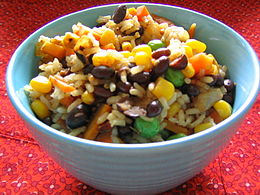 The study results of 218 overweight, postmenopausal women who had insufficient levels of vitamin D (like most people) at the beginning of the study found that weight loss (including exercise), in combination with vitamin D supplementation, had a greater effect on reducing chronic inflammation than weight loss alone.
The study results of 218 overweight, postmenopausal women who had insufficient levels of vitamin D (like most people) at the beginning of the study found that weight loss (including exercise), in combination with vitamin D supplementation, had a greater effect on reducing chronic inflammation than weight loss alone.
Current thinking is that chronic inflammation is linked to various chronic diseases as well as cancers. So reducing chronic inflammation is good. From Medical Xpress:
Weight loss plus vitamin D reduces inflammation linked to cancer, chronic disease
For the first time, researchers at Fred Hutchinson Cancer Research Center have found that weight loss, in combination with vitamin D supplementation, has a greater effect on reducing chronic inflammation than weight loss alone. Chronic inflammation is known to contribute to the development and progression of several diseases, including some cancers.
"We know from our previous studies that by losing weight, people can reduce their overall levels of inflammation, and there is some evidence suggesting that taking vitamin D supplements can have a similar effect if one has insufficient levels of the nutrient," said lead and corresponding author Catherine Duggan, Ph.D., a principal staff scientist in the Public Health Sciences Division at Fred Hutch.
To explore this question, Duggan and colleagues recruited 218 healthy, overweight older women who had lower-than-recommended levels of vitamin D (less than 32 ng/mL). The women then took part in a 12-month diet and exercise program (including 45 minutes of moderate-to-vigorous exercise five days a week). Half of the study participants were randomly selected to receive 2,000 IU of vitamin D daily for the duration of the year-long trial, and the other half received an identical-appearing placebo, or dummy vitamin.
At the end of the study, all of the participants had reduced levels of inflammation, regardless of whether they took vitamin D, "which highlights the importance of weight loss in reducing inflammation," Duggan said. However, those who saw the most significant decline in markers of inflammation were those who took vitamin D and lost 5 to 10 percent of their baseline weight. These study participants had a 37 percent reduction in a pro-inflammatory cytokine called interleukin-6, or IL-6, as compared to those in the placebo group, who saw a 17.2 percent reduction in IL-6. The researchers found similar results among women in the vitamin D group who lost more than 10 percent of their starting weight. While IL-6 has normal functions in the body, elevated levels are associated with an increased risk of developing certain cancers and diabetes and may be implicated as a cause of depression, Duggan said.
Inflammation occurs when the body is exposed to pathogens, such as bacteria or viruses, which puts the immune system in overdrive until the "attack" ceases and the inflammatory response abates. Overweight or obese people, however, exist in a state of chronic inflammation. This sustained upregulation of the inflammatory response occurs because fat tissue continually produces cytokines, molecules that are usually only present for a short time, while the body is fighting infection, for example.
"It is thought that this state of chronic inflammation is pro-tumorigenic, that is, it encourages the growth of cancer cells," she said. There is also some evidence that increased body mass "dilutes" vitamin D, possibly by sequestering it in fat tissue."Weight loss reduces inflammation, and thus represents another mechanism for reducing cancer risk," Duggan said. "If ensuring that vitamin D levels are replete, or at an optimum level, can decrease inflammation over and above that of weight loss alone, that can be an important addition to the tools people can use to reduce their cancer risk."

 New research finding health benefits to humans from a four day low calorie diet - the Fasting Mimic Diet (FMD). Cutting calories to 34 to 54% of normal for a few days is obviously much easier to do than actual fastiing, so these results look very promising. In summary: the researchers found that in a small human trial, three cycles of this diet given to 19 subjects once a month for five days decreased risk factors and biomarkers for aging, diabetes, cardiovascular disease and cancer (and with no major adverse side effects). Three earlier posts on various types of minifasting health benefits:
New research finding health benefits to humans from a four day low calorie diet - the Fasting Mimic Diet (FMD). Cutting calories to 34 to 54% of normal for a few days is obviously much easier to do than actual fastiing, so these results look very promising. In summary: the researchers found that in a small human trial, three cycles of this diet given to 19 subjects once a month for five days decreased risk factors and biomarkers for aging, diabetes, cardiovascular disease and cancer (and with no major adverse side effects). Three earlier posts on various types of minifasting health benefits:  Stop drinking soda every day! Research finds that a daily sugar-sweetened beverage habit may increase the risk for non-alcoholic fatty liver disease (NAFLD). Earlier research has already linked daily sugar-sweetened beverages (typically soda) to
Stop drinking soda every day! Research finds that a daily sugar-sweetened beverage habit may increase the risk for non-alcoholic fatty liver disease (NAFLD). Earlier research has already linked daily sugar-sweetened beverages (typically soda) to  People are correctly raising the issue of whether the positive results (less diabetic nerve pain in type 2 diabetics) are due to the weight loss or to the vegan diet (which caused the quick weight loss)? I suspect it's the
People are correctly raising the issue of whether the positive results (less diabetic nerve pain in type 2 diabetics) are due to the weight loss or to the vegan diet (which caused the quick weight loss)? I suspect it's the  This study, like previous research, found an association between increased
This study, like previous research, found an association between increased  Controversy exists over whether healthy people should take
Controversy exists over whether healthy people should take  The statements in this editorial may be obvious to many, but it is nicely written and needs to be said. Basically it says that exercise will not help you overcome the ill effects of a poor diet. I agree with what was said, but felt that what was missing was mention that a poor diet also has negative effects on the microbiome (the community of microbes living within the person) - which we know is linked to health problems.
The statements in this editorial may be obvious to many, but it is nicely written and needs to be said. Basically it says that exercise will not help you overcome the ill effects of a poor diet. I agree with what was said, but felt that what was missing was mention that a poor diet also has negative effects on the microbiome (the community of microbes living within the person) - which we know is linked to health problems. Note that both eggs and high-fat dairy products were basically considered evil by the medical establishment for many years. Remember egg white omelettes?And now both are thought to have health benefits, especially reducing the risk of diabetes. From Science Daily:
Note that both eggs and high-fat dairy products were basically considered evil by the medical establishment for many years. Remember egg white omelettes?And now both are thought to have health benefits, especially reducing the risk of diabetes. From Science Daily: Discussions of the benefits of dietary fiber seem to be everywhere this week.
Discussions of the benefits of dietary fiber seem to be everywhere this week.